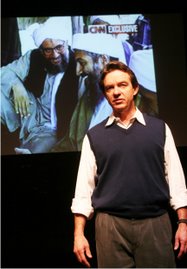In “The Assault on Reason” Al Gore excoriates George W. Bush, asserting that the president is “out of touch with reality,” that his administration is so incompetent that it “can’t manage its own way out of a horse show,” that it ignored “clear warnings” about the terrorist threat before 9/11 and that it has made Americans less safe by “stirring up a hornets’ nest in Iraq,” while using “the language and politics of fear” to try to “drive the public agenda without regard to the evidence, the facts or the public interest.”
The administration’s pursuit of unilateralism abroad, Mr. Gore says, has isolated the United States in an ever more dangerous world, even as its efforts to expand executive power at home and “relegate the Congress and the courts to the sidelines” have undermined the constitutional system of checks and balances.
The former vice president contends that the fiasco in Iraq stems from President Bush’s use of “a counterfeit combination of misdirected vengeance and misguided dogma to dominate the national discussion, bypass reason, silence dissent and intimidate those who questioned his logic both inside and outside the administration.”
He argues that the gruesome acts of torture committed at Abu Ghraib prison in Iraq “were a direct consequence of the culture of impunity — encouraged, authorized and instituted” by President Bush and former Defense Secretary Donald H. Rumsfeld. And he writes that the violations of civil liberties committed by the Bush-Cheney administration — including its secret authorization of the National Security Agency to eavesdrop without a court order on calls and e-mail messages between the United States and other countries, and its suspension of the rights of due process for “enemy combatants” — demonstrate “a disrespect for America’s Constitution that has now brought our republic to the brink of a dangerous breach in the fabric of democracy.”
Similar charges have been made by a growing number of historians, political analysts and even former administration insiders, and President Bush’s plummeting approval ratings have further emboldened his critics. But Mr. Gore writes not just as a former vice president and the man who won the popular vote in the 2000 election, but also as a possible future candidate for the Democratic nomination in the 2008 race for the White House, and the vehemence of his language and his arguments make statements about the Bush administration by already announced candidates like Barack Obama and Hillary Rodham Clinton seem polite and mild-mannered in contrast.
And yet for all its sharply voiced opinions, “The Assault on Reason” turns out to be less a partisan, election-cycle harangue than a fiercely argued brief about the current Bush White House that is grounded in copiously footnoted citations from newspaper articles, Congressional testimony and commission reports — a brief that is as powerful in making its points about the implications of this administration’s policies as the author’s 2006 book, “An Inconvenient Truth,” was in making its points about the fallout of global warming.
This volume moves beyond its criticisms of the Bush administration to diagnose the ailing condition of America as a participatory democracy — low voter turnout, rampant voter cynicism, an often ill-informed electorate, political campaigns dominated by 30-second television ads, and an increasingly conglomerate-controlled media landscape — and it does so not with the calculated, sound-bite-conscious tone of many political-platform-type books, but with the sort of wonky ardor that made both the book and movie versions of “An Inconvenient Truth” so bluntly effective.
Mr. Gore’s central argument is that “reason, logic and truth seem to play a sharply diminished role in the way America now makes important decisions” and that the country’s public discourse has become “less focused and clear, less reasoned.” This “assault on reason,” he suggests, is personified by the way the Bush White House operates. Echoing many reporters and former administration insiders, Mr. Gore says that the administration tends to ignore expert advice (be it on troop levels, global warming or the deficit), to circumvent the usual policy-making machinery of analysis and debate, and frequently to suppress or disdain the best evidence available on a given subject so it can promote predetermined, ideologically driven policies.
Doubts about Saddam Hussein’s pursuit of weapons of mass destruction were sidestepped in the walk-up to the war: Mr. Gore says that uranium experts at the Oak Ridge National Laboratory in Tennessee told him “there was zero possibility” that aluminum tubes acquired by Saddam Hussein were for the purpose of nuclear enrichment, but felt intimidated from “making any public statement that disagreed with the assertions being made to the people by President Bush.”
And the Army chief of staff Gen. Eric K. Shinseki’s pre-invasion recommendation that several hundred thousand troops would be needed for a successful occupation of Iraq was similarly dismissed. “Rather than engaging in a reasoned debate on the question,” Mr. Gore writes, administration members “undercut Shinseki for disagreeing with their preconceived notion — even though he was an expert, and they were not.”
Moreover, Mr. Gore contends, the administration’s penchant for secrecy (keeping everything from the details of its coercive interrogation policy to its National Security Agency surveillance program under wraps) has dismantled the principle of accountability, even as what he calls its “unprecedented and sustained campaign of mass deception” on matters like Iraq has made “true deliberation and meaningful debate by the people virtually impossible.”
Mr. Gore points out that the White House repeatedly implied that there was a connection between Al Qaeda and Saddam Hussein, between the terrorist attacks of 9/11 and Iraq, when in fact no such linkage existed. He observes that the administration “withheld facts” from Congress concerning the cost of the Medicare prescription drug benefit, which turned out to be “far higher than the numbers given to Congress by the president.”
And he contends that “it has become common for President Bush to rely on special interests” — like those represented by the Iraqi exile Ahmad Chalabi before the war, and ExxonMobil on the climate crisis — for “basic information about the policies important to these interests.”
...
Much the way that the movie “An Inconvenient Truth” showed a more accessible Al Gore — at ease with himself and passionate about the dangers of global warming — this book shows a fiery, throw-caution-to-the winds Al Gore, who, whether or not he runs for the White House again, has decided to lay it all on the line with a blistering assessment of the Bush administration and the state of public discourse in America at this “fateful juncture” in history.
We applaud Mr. Gore's efforts: In an age of journalistic weakness, he has joined Lewis Lapham, a handful of bloggers, and too few others in his commitment to tell the truth -- even about the president, even about money -- even if the oil barons and CIA bunglers would prefer that the illusion of an omnipotent, universally and infinitely good-hearted American Government remain the only image that government casts.
More good news we recommend to you:
May 22, 2007, "An Old Steel Mill Retools to Produce Clean Energy," By DAVID STABA:
LACKAWANNA, N.Y., May 21 — Empty grain elevators and dormant railroad tracks line the Buffalo River to the east and Lake Erie to the west, interspersed with empty fields overgrown with gnarled shrubbery. Test wells that monitor decades of buried industrial waste dot the landscape. A passenger ship, rust overtaking its aqua paint, sits beside a decaying mill.
The road from Buffalo to this city to the south offers a stark reminder of the region’s faded past as a hub of industry and shipping.
Yet in the past few months, a different sight has emerged on the 2.2-mile shoreline above a labyrinth of pipes, blackened buildings and crumbling coke ovens that was once home to a behemoth Bethlehem Steel plant: eight gleaming white windmills with 153-foot blades slowly turning in the wind off Lake Erie, on a former Superfund site where iron and steel slag and other industrial waste were dumped during 80 years of production.
“It’s changing the image of the city of Lackawanna,” said Norman L. Polanski Jr., the city’s mayor and a former Bethlehem worker who lost his job when the company stopped making steel here in 1983. “We were the old Rust Belt, with all the negatives. Right now, we are progressive and we are leading the way on the waterfront.”
Christine Real de Azua, of the American Wind Energy Association, said Steel Winds, as this wind farm is known, is the largest to rise in a city, and according to the state Department of Environmental Conservation, it is the first to rise on land overseen by New York’s brownfields program. (Brownfields are low-level toxic waste sites concentrated mainly around abandoned factories.)
“It’s a way to convert the Rust Belt to the Wind Belt,” Ms. Real de Azua said.
...
The greatest effect of the eight windmills, however, may have more to do with attitude.
“A community that has had difficulty moving forward has accepted a technology that leapfrogs other forms of energy generation,” Mr. Mitskovski said. “Decades of steel-making created this environmental legacy. But that also created the opportunity to take this fallow, contaminated land and reuse it.”
And once more, from Atlanta:
May 22, 2007, "Executive on a Mission: Saving the Planet," By CORNELIA DEAN
VININGS, Ga. — What Ray Anderson calls his “conversion experience” occurred in the summer of 1994, when he was asked to give the sales force at Interface, the carpet tile company he founded, some talking points about the company’s approach to the environment.
“That’s simple,” Mr. Anderson recalls thinking. “We comply with the law.”
But as a sales tool, “compliance” lacked inspirational verve. So he started reading about environmental issues, and thinking about them, until pretty soon it hit him: “I was running a company that was plundering the earth,” he realized. “I thought, ‘Damn, some day people like me will be put in jail!’ ”
“It was a spear in the chest.”
So instead of environmental regulation, he devoted his speech to his newfound vision of polluted air, overflowing landfills, depleted aquifers and used-up resources. Only one institution was powerful enough and pervasive enough to turn these problems around, he told his colleagues, and it was the institution that was causing them in the first place: “Business. Industry. People like us. Us!”
He challenged his colleagues to set a deadline for Interface to become a “restorative enterprise,” a sustainable operation that takes nothing out of the earth that cannot be recycled or quickly regenerated, and that does no harm to the biosphere.
The deadline they ultimately set is 2020, and the idea has taken hold throughout the company. In a recent interview in his office here overlooking downtown Atlanta, Mr. Anderson said that through waste reduction, recycling, energy efficiency and other steps, Interface was “about 45 percent from where we were to where we want to be.”
Use of fossil fuels is down 45 percent (and net greenhouse gas production, by weight, is down 60 percent), he said, while sales are up 49 percent. Globally, the company’s carpet-making uses one-third the water it used to. The company’s worldwide contribution to landfills has been cut by 80 percent.
“He bet his entire company,” said Bob Fox, an architect who specializes in “green” buildings and who, like Mr. Anderson, is a member of the advisory board of the Harvard Center for Health and the Global Environment. “It worked out probably better even than he hoped. He has set the mark for every other corporation in this country.”
And in the process, Mr. Anderson has turned into perhaps the leading corporate evangelist for sustainability. He had a head start, he acknowledges, because he ran his company and controlled its voting stock. But he can make the case effectively, he said, because his Interface experience teaches that sustainability “doesn’t cost, it pays” — in customer loyalty, employee spirit and hard cash. He says Interface sustainability efforts have saved the company more than $336 million since 1995.
In fact, sustainability has been such a successful strategy that Interface established a consulting arm last year, to market its methods to other companies.
As befits an evangelist, Mr. Anderson, a trim 72-year-old, has taken his message on the road, preaching the sermon of sustainability in at least 115 speeches around the world last year alone.
Since last year, when he turned operating responsibilities over to Dan Hendrix, his successor as chief executive, selling sustainability has been “pretty much my full-time job,” Mr. Anderson said, and several people on the company payroll work more or less full time on it too, handling his schedule and fielding inquiries. “I think he was a typical corporate executive: the bottom line was everything,” said Eric Chivian, director of the Harvard Center. “He really did not think about the impact of his work.”
But today, Dr. Chivian said, Mr. Anderson is “a model of creative thinking about sustainable business practices.”
When Mr. Anderson began his crusade, there were those who thought it was quixotic, and some in the company worried that he was a bit too intense about it. Others thought carpet tiles — squares of nylon pile glued ubiquitously underfoot in offices, classrooms, hospitals, airports and elsewhere — were an unlikely focus for an effort to change the way business does business.
“Well, he won us all over,” said Jo Ann Bachman, one of Mr. Anderson’s assistants.
...
So he put together the necessary financing and started Interface in 1973. Today, the company says it has about $1.1 billion in annual sales and 38 percent of the global market for carpet tiles.
But when it comes to the environment, he eventually realized, carpet “is a pretty abusive industry.”
Carpet makers use lots of petroleum and petroleum derivatives, both as components of synthetic carpet and to power its production. Dyeing carpet is water- and energy-intensive. And when people are finished with the carpet, “it goes into landfills where it lasts probably 20,000 years,” Mr. Anderson said. “Abusive.”
So he challenged his employees to find ways to turn all of that around. And he forestalled objections from his own stockholders, he said, by making the elimination of waste the first target. “We saved money from Day 1,” he said.
He acknowledges that some of the advances the company has made so far are relatively obvious and easy, and that some of its claimed progress relies on steps, like carbon credits, that are far from ideal. For example, the company pays to plant trees that, in theory, take up enough carbon to compensate for the greenhouse gas generated by airplane flights on company business.
“All you are really doing is inventorying the carbon for 200 years,” Mr. Anderson said of the company’s tree-planting efforts, which it subcontracts to a company in the carbon credit business. “It’s better than nothing, but it’s temporary.”
In the future, he said, progress will come “in a lot of little steps and a few very big ones.”
Developing recyclable nylon — “that’s a big step,” he said. (Whoever does it will get all his company’s business, he has said.) Substituting “carbohydrates” — using corn dextrose instead of petroleum — would be even bigger. Renewable energy at a reasonable price would be another big step. Transportation remains “a huge issue,” in spite of the carbon credits.
Even so, customers responded to the campaign, he said, noting that it was questions from customers that prompted the sales force to ask for his environmental views in the first place. “In the aggregate, our products are not costing any more,” he said, and customers do not seem to resist those that are more expensive. “Our profit margins are up, not down,” he said.
...
And after an argument with the landlord, Interface’s office space here is now illuminated with low-energy, long-life light bulbs.
Mr. Anderson is also proud to say that as a member of an advisory council at Georgia Tech, he persuaded the institution to modify its mission statement to proclaim the goal of “working for a sustainable society.”
...
After the speech, he said, “I heard the whispers, ‘Has he gone round the bend?’ ” Mr. Anderson recalls proudly how he confessed at once that he had. “That’s my job,” he said. “To see what’s around the bend.”




No comments:
Post a Comment